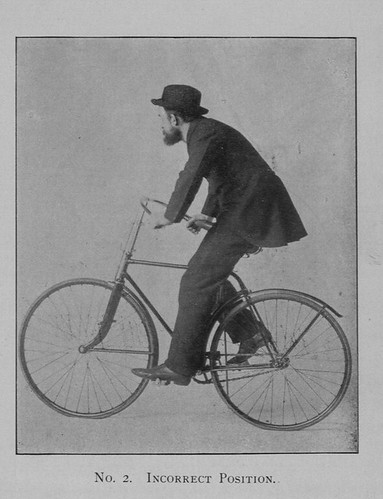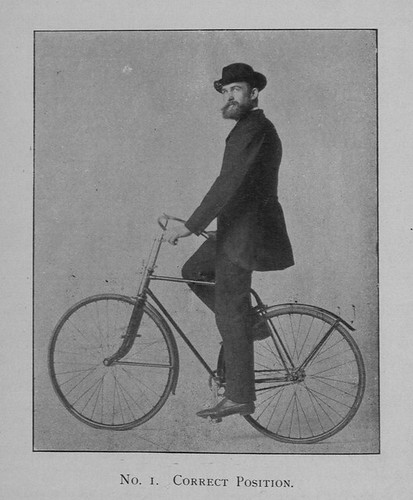When the first diamond frame bicycles became popular in the 1890s they were often called "wheels" - the national cycling association was called the "League of American Wheelmen." We have moved from "wheels" to "bikes," but the bicycles have remained remarkably the same over more than 100 years - elegant in their efficiency and simplicity. And many of the issues that we think are new? They were around then too.
Showing posts with label books. Show all posts
Showing posts with label books. Show all posts
Saturday, September 4, 2010
The Rider by Tim Krabbé
Krabbé's "The Rider" was only published in English (in the US, anyway) about 25 years after it was originally published in Dutch. This mostly a minute-by-minute tracking of a bike racer's thoughts, beginning to end, during a one-day bike racing event. At around 150 pages, you can fly through it but it is better to take one's time and enjoy it.
Wednesday, August 25, 2010
Epic bicycle journeys - books
Am reading "The Lost Cyclist," a history of an American, Frank Lenz, who disappeared in Turkey during a ride "around the world" in the early 1890s. Two other young Americans were also riding around the world at roughly the same time and eventually one of them went searching for Lenz. These two Americans published a book describing their travels that is available full text.
Friday, August 13, 2010
The Competition Bicycle
The Competition Bicycle from Vintage Bicycles Press in Seattle - lovely to look through. I should subscribe to their The Bicycle Quarterly as well.
Wednesday, August 4, 2010
Classic book of early cycling
The American bicycler: a manual for the observer, the learner, ... predates the "safety bicycle" and describes bicycles with the oversize front wheel and the tiny back wheel as the state-of-the-art. (The so-called "ordinary.") Published in 1879.
From HathiTrust - digitized by Google at the University of Michigan.
The weight of roadsters varies between thirty-fiveSixty pounds! Wow ~
and sixty pounds, and of racers between twenty and
thirty-five pounds. The diameter of front wheel
ranges from forty to sixty inches, —forty-eight, fifty,
fifty-two, and fifty-four inches being the most com-
mon sizes ; and the wheel is chosen to fit the rider
as pantaloons arc, —according to length of leg, &c.
The whole is made in form and finish, lines and pro-
portions, with a view to comely appearance as well
as utility, and, when mounted by an accomplished
rider, is remarkably handsome.
From HathiTrust - digitized by Google at the University of Michigan.
Sunday, August 1, 2010
The Bicycle: It's Selection, Riding and Care (1892)
The Bicycle: It's Selection, Riding and Care is a book (or more like a booklet) published in 1892. The "safety bicycle" (with two wheels of equal size like today's bikes) only became common in the 1880s so for many this was new information, as evidenced by chapters with titles such as "How to Dress," "How to Ride," and before that, "How to Learn to Ride."
Below we see the "incorrect" position for riding a bike, according to this book. Perhaps the fellow is simply having too much of a devil-may-care time??

Here is the "correct" position ~

Below we see the "incorrect" position for riding a bike, according to this book. Perhaps the fellow is simply having too much of a devil-may-care time??

Here is the "correct" position ~

Saturday, July 31, 2010
Spaldings Official Bicycle Guide for 1899
Spalding's Official Bicycle Guide for 1899 was digitized at the Library of Congress and is available from the Internet Archive. The publication is at once a review of the top bicycle racers at the time and advice for the novice. There is rather amusing analysis of bike saddle design based on anatomical features, with skeletal bottoms pearched on various saddles.
The "advice" seems to find much wrong with the person receiving the advice, sight unseen. For example, on the subject of "Why Chains Often Break" we read:
The reasons for this trouble are various, but tradesmen hold to the
opinion that it is mostly the chains on cheap wheels which have been
neglected all winter that break in the spring. They are rusty and
worn, and consequently weaker than they were. When taken out on
the road without being cleaned or adjusted the dust gets in them and
tightens them up so that an extra strain is imposed, under which they
part. Another cause is the erratic pedalling of riders who have never
learned how to properly manipulate their feet on a bicycle. The top
stretch of the chain is allowed to slacken and is then tightened sud-
denly by a violent thrust. Then it snaps.
So if your chain breaks, it is because you bought a cheap bike and then didn't take good care of it as well, so it's all your fault.
The "advice" seems to find much wrong with the person receiving the advice, sight unseen. For example, on the subject of "Why Chains Often Break" we read:
The reasons for this trouble are various, but tradesmen hold to the
opinion that it is mostly the chains on cheap wheels which have been
neglected all winter that break in the spring. They are rusty and
worn, and consequently weaker than they were. When taken out on
the road without being cleaned or adjusted the dust gets in them and
tightens them up so that an extra strain is imposed, under which they
part. Another cause is the erratic pedalling of riders who have never
learned how to properly manipulate their feet on a bicycle. The top
stretch of the chain is allowed to slacken and is then tightened sud-
denly by a violent thrust. Then it snaps.
So if your chain breaks, it is because you bought a cheap bike and then didn't take good care of it as well, so it's all your fault.
1900 Columbia Bike (or Wheel . . . ) catalog
Columbia and Hartford Bicycles 1900 Bicycle catalog for Pope Manufacturing Company for the year. Interesting how little, in many respects, bicycles have changed.

One thing that has changed is that at that time "chainless" drive was considered to be the new advanced approach (with a drive shaft, rather than chain). The bikes in this catalog with shaft drive cost significantly more, and although it wasn't apparently possible to discern this at the time readily, were less efficient, so perhaps it is not surprising that it never really caught on.

From time to time different companies try to revive "chainless" bikes with shaft drive, but as long as the main power source is the rider, it seems unlikely to catch on. (Perhaps when bikes with powered assist are more common it will do better.)
Wikipedia has a description of chainless bikes that covers the subject pretty well.
Page turner presenting full 1900 catalog of Columbia bikes

One thing that has changed is that at that time "chainless" drive was considered to be the new advanced approach (with a drive shaft, rather than chain). The bikes in this catalog with shaft drive cost significantly more, and although it wasn't apparently possible to discern this at the time readily, were less efficient, so perhaps it is not surprising that it never really caught on.

From time to time different companies try to revive "chainless" bikes with shaft drive, but as long as the main power source is the rider, it seems unlikely to catch on. (Perhaps when bikes with powered assist are more common it will do better.)
Wikipedia has a description of chainless bikes that covers the subject pretty well.
Page turner presenting full 1900 catalog of Columbia bikes
The Paterek Manual for Bicycle Framebuilders
Tim Paterek is a retired framebuilder who published a detailed guide to how to build steel bicycle frames. There is lots of good information about sizing bicycles and how to understand aspects of bicycle design in addition to the "how to build" info.
Paterek.com provides the ability to purchase the new third edition.
Paterek Manual is a PDF of the first edition, which he has made available apparently because Paterek was annoyed that a Russian pirate was offering it.
One of my favorite bits so far is the guidance for the distance from the front end of the saddle to the front of the stem is "one cubit" - which is the distance from the elbow to the end of the fingers (and specific to an individual, naturally).
Paterek.com provides the ability to purchase the new third edition.
Paterek Manual is a PDF of the first edition, which he has made available apparently because Paterek was annoyed that a Russian pirate was offering it.
One of my favorite bits so far is the guidance for the distance from the front end of the saddle to the front of the stem is "one cubit" - which is the distance from the elbow to the end of the fingers (and specific to an individual, naturally).
Subscribe to:
Posts (Atom)